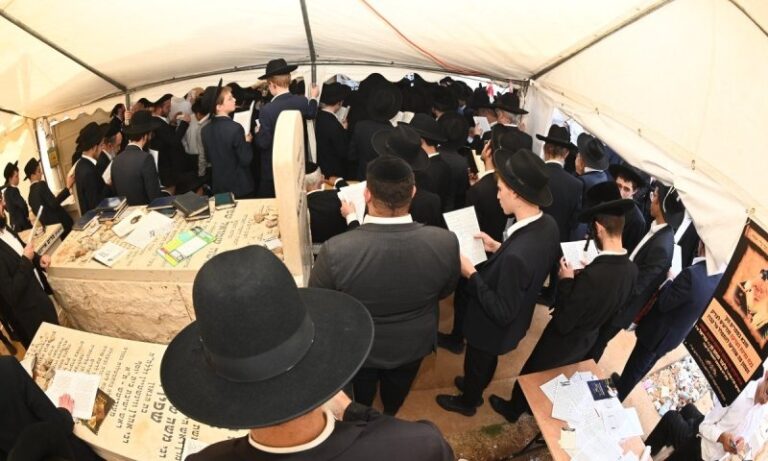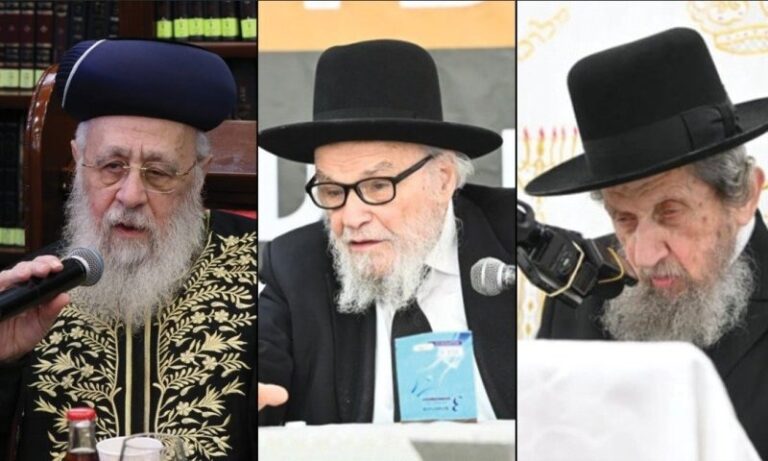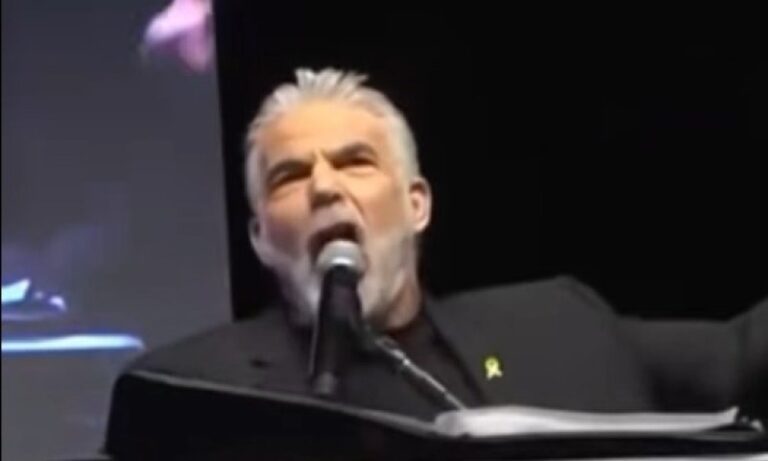 Forty years ago, in the shadow of the Six Day War, the Editor of the Panim El Panim Newspaper, Shmuel Avigdor HaKohen, made his way to Williamsburg, where he was granted an unprecedented opportunity to enter the Satmar Rebbe’s private chambers & interview him on the pressing issues of the day. Sha’ah Tovah now presents the full text of the interview, for the first time since its original publication – The Impressions Of An Outsider.
Forty years ago, in the shadow of the Six Day War, the Editor of the Panim El Panim Newspaper, Shmuel Avigdor HaKohen, made his way to Williamsburg, where he was granted an unprecedented opportunity to enter the Satmar Rebbe’s private chambers & interview him on the pressing issues of the day. Sha’ah Tovah now presents the full text of the interview, for the first time since its original publication – The Impressions Of An Outsider.
Williamsburg, 1967:
The streets of Williamsburg were covered with a thick blanket of snow. The snowflakes continued to fall, covering my glasses and pricking my forehead and cheeks. Occasionally, a fire engine with siren howling passed through the neighborhood, cutting through the feathers of snow swirling in the air. Bearded Jews wrapped in black coats and wearing wide-brimmed chassidic hats hurried through the streets to reach one of the many batei medrash in the area, in order to catch a minyan for Minchah and Maariv. A large yellow bus picked up its load of children, their long peyos framing their faces, to transport them home after a day of study in the Talmud Torah.
A large metal sign with the words “Glatt Kosher” had fallen from the weight of the snow that had topped it, and now lay desolate on the sidewalk. Shoppers scurried between the butcher’s and the grocery stores. The men were dressed in Hungarian chassidic dress, and the women had silk scarfs covering their heads. The shoppers and store owners all conversed in a rich Yiddish dialect, and only here and there could one detect a word of English that had slipped into their conversations. At the top of Lee Avenue I spied R’ Lipa Friedman, his coat tightly pulled around him. The principal of the ‘Torah V’Yirah’ and ‘Bais Rochel’ institutions, he had just finished a phone call to hear details of how the day had gone in the yeshivah gedolah, which had just moved into the Navy building after the former residents vacated it. A dark-bearded avreich with sharp black eyes stopped to tell him that, “Baruch Hashem, everything went well in the Talmud Torah. Despite the heavy snow, close to a thousand students arrived and only eight children didn’t show up. Not one of the melamdim
was missing.” A smile of satisfaction spread over R’ Lipa’s wrinkled face.
A car stopped next to one of the houses on Bedford Avenue. Several bochurim gathered around it, jostling each other as they try to stake a good place. On the wide steps leading down from the brownstone builidng, an illustrious- looking elderly man was making his way down. His body was sunken into his wide coat and he held a thin cane with a silver handle. Several avreichim helped him walk down the hard, slippery ice that coated the steps. Beneath his hat could be detected white peyos. His silvery, shiny beard framed an intense face. Thick black eyebrows graced his smiling eyes. The Rebbe, Harav Yoel Teitelbaum of Satmar, was on his way to visit his yeshivah gedolah in the Navy building next to the bank of the East River. Despite the miserable weather, he wouldn’t forego his weekly visit to the yeshivah to test the students and oversee their progress in the sugya they were currently learning. For the 652 bochurim who were sitting and learning the sugya of “simonim”, the Rebbe’s visit was the highlight of their week. R’ Yosef Ashkenazy, the Rebbe’s main gabbai, utilized the time that the Rebbe was at the yeshivah to take a break at his own home. Most of the day he didn’t budge from the Rebbe’s house. He received visitors from all over the world, dealt with deliveries, read the letters and sorted them, arranged visits for those who came to speak with the Rebbe, kept in touch with R’ Shabsai Mordechai Berkowitz, the general secretary of Hisachdus HaRabbonim, received updates from Shlomo Gefen, the director of the Satmar educational institutions in Eretz Yisrael, and answered the unending stream of phone calls.
This was also the time of day that R’ Sender Deutsch would arrive at his printing shop. He checked his current work, gave instructions to his workers, and sat to write his articles for the Der Yid weekly. R’ Deutsch wrote his articles in a most original way; he arranged them in lead letters straight onto his electronic layout machine without first recording them on paper.
After a stay of several hours at the yeshivah, the Rebbe returned to his home on Bedford Avenue. His shammash, R’ Avraham Wurtzberger, was the person who always accompanied the Rebbe – and also the Rebbe’s private shochet. He cleared a path through the people crowding the steps and the long corridor leading to the apartment. After a short rest, the Rebbe
entered his reception room, and one of his assistants decided the order in which those waiting would enter to speak with him privately. There were many people crowded in the waiting room. They included a dayan from a prominent Jewish community in England who had come for a few days to New York and wouldn’t think of returning without first meeting the Rebbe; a young rav, one of the heads of the Hisachdus HaRabbanim who was waiting to discuss several burning public issues affecting religious American Jewry with the Rebbe; a distinguished Jew from Batei Ungarin in Yerushalayim who wanted to present the Rebbe with a sefer on the Rambam authored by his son-in-law; a wealthy industrialist from Venezuela; and numerous others.
Many of them were cluching a note on which was written their request, a kvittel that was accompanied by a pidyon nefesh. From time to time, the door opened and the last one who had entered the room came out. Everyone was overwhelmed, either sweating nervously or flushed with excitement. The door swallowed up the next one in line. From outside, one could hear the Rebbe’s voice but couln’t distinguish the words said.
MY TURN ARRIVES TO ENTER THE REBBE’S CHAMBERS
While everyone was waiting their turn, I sat in a nearby apartment with several of the communal leaders of the Chassidus and had a friendly chat about Satmar. They told me about the amazing growth of the Satmar Torah institutions and schools. In this part of Williamsburg, not less than 4,000 boys were studying in Torah V’Yirah yeshivos, from little three-year-olds to bochurim aged up to fifteen. After finishing their studies there, they go on to the Mesivta Gedolah. Parallel to the yeshivah ketanah, they have an excellent school for girls called
Bais Rochel which includes both elementary and high schools. The curriculum includes general secular studies as well as vocational studies and home management. I doubt if even most New York Jews are aware of Satmar’s impressive achievements in the field of education. “After Yeshiva University with all of its various branches,” R’ Lipa Friedman told me, “our institutions are the next biggest. If we take in consideration that Yeshivas Rabbi Yitzchak Elchonon of Yeshiva University has been in existence for over eighty years, while the Satmar schools were only established after the Holocaust by refugees who came from Europe to the U.S., our achievement is immense. There is nothing else like it in the entire Jewish world.”
Education is the crowning achievement of the Satmar community, which calls itself “Yetev Lev” after the name of the sefer written by the Admor Harav Yekusiel Yehuda Teitelbaum of Sighet ztz”l, the grandfather of the Satmar Rebbe.
The community’s services cover many different areas and are meticulously organized and incredibly reliable. As one devoted religious Zionist told me – who seethed at the Satmar opposition to the State of Israel – “What can I do? I buy meat from them, because I know that their kashrus supervision is the best!”
Before my turn arrived to see the Rebbe, I spoke with several people at the top of the Satmar hierarchy about their educational system. They highlighted the Mesivta for bochurim ages fifteen until marriage (which is usually between twenty and twenty-two). The Mesivta suffered for years from lack of suitable premises. Then one day, they heard that the American navy was vacating one of its main buildings in the Navy district next to the bank of the East River. The Satmar community immediately began negotiations to acquire the building. They managed to rent it and plan in the near future to purchase it. This building contains a number of large halls and dozens of residential units, now occupied by the 652 bochurim of the Mesivta, who take their meals there – many of them sleep there too. Beneath the building they built a mikveh and a library. As mentioned already, the Rebbe comes every week to give shiurim and examine the students. A few days later, I toured several of their institutions including the Mesivta building. It was even more impressive than their descriptions.
The telephone rang and a message was relayed from the Rebbe’s house that my turn had arrived to enter the Rebbe’s chambers. Accompanied by the editor of Der Yid, R’ Sender Deutsch, I made my way over. I waited several minutes in the waiting room, where many others were waiting to go in after me. Someone came out of the Rebbe’s chambers, and then R’ Yosef Ashkenazy opened the door and motioned to me.
I enter a large lavishly furnished room of eight meters in length and six meters wide. In the center is a huge table which takes up much of the space. On a wide, upholstered chair sits the Rebbe, Harav Yoel Teitelbaum of Satmar, the great warrior against Zionism, the venerated leader of tens of thousands of chareidi Jews throughout the world, the author of the controversial sefer Vayoel Moshe.
He is one of the last remnants of the mighty Torah sages and chassidic leaders who existed before the Holocaust, a great gaon whose opponents freely admit to his all-encompassing knowledge. He is a scion of the Sighet dynasty of great tzaddikim, from whom my grandfather, the mekubal Harav Chanoch Chaim Hakohen ztz”l of Yerushalayim learned Torah and
Chassidus.
As I approach the Rebbe’s seat, I notice many kvittelach spread out on the table. They are the kvittelach of those who preceded me. Among them are many currencynotes from various countries around the world: dollars, English pounds, Austrian schillings, Belgian francs, Canadian dollars…. The Rebbe is clad in a shiny blue silk robe, and wears a wide-brimmed velvet hat that sits like a crown above his high, fair-skinned, slightly wrinkled forehead. His look is penetrating, his black eyebrows droop downwards and from time to time,
hide the pupils of his eyes. His lips are thin and a hint of a shrewd smile can be detected at the corners of his mouth, which opens into an occasional smile depending on the topic being discussed.
“THEY WANT TO CRUSH THE SPIRIT OF EVERY BELIEVING JEW”
While the Rebbe sizes me up from head to toe, I introduce myself; “I am the grandson of Harav Chanoch Chaim Munkaczer.” The Rebbe immediately asks me with a chuckle, “Did you come here as the grandson of your grandfather, or on behalf of Panim El Panim?” I answer, “Both of them together.” The Rebbe says, “I remember your grandfather from when he came from Yerushalayim to visit in Munkacz. He stayed by me in nearby Burshova. I can still picture him. Yes, Harav Chaim Hakohen, Rav Chaim from Yerushalayim. He was a kosher Yid, he was the main trustee for the Rabbi Meir Baal HaNess funds. Nu, did anything remain in you from your grandfather? Hmmm…?”
The Rebbe points to a chair and invites me to sit. When he hears that I have come from Eretz Yisroel, he asks me, “Nu, what do you hear from there?” I tell him frankly that the financial situation has worsened, and about political entanglements. “Despite that, they are still eager to persecute chareidi Jews?” the Rebbe interrupts my description.
“I don’t think they have such an intention,” I try to soften his stance. But the Rebbe of Satmar is certain that those who persist in performing autopsies do so only to indoctrinate the public not to believe in the revival of the dead and the immortality of the soul. “Nowhere else in the world is there such a large number of autopsies. It far exceeds their medical needs,” he said with a sigh, immediately adding, “There is no other logical explanation, but that they want to crush the spirit of believing Jews into the dust.”
The Rebbe relates that he receives detailed reports about this matter. He has the names of those upon whom autopsies were carried out. He knows that only two days ago, they mutilated a body again, this time too without an acceptable medical justification. “The matter must come to an end,” he says, and I realize that he will have no peace until they notify him from Yerushalayim that “the decree has been abolished.” If the large demonstration didn’t help, the one which was held several weeks ago in New York in which tens of thousands of religious Jews from every group participated, there will be another demonstration and then yet another. They will demonstrate next to the United Nations, they will demonstrate in Washington. “We didn’t start with demonstrations. There were many other attempts to cancel the decree. We have no interest in battles. But experience has shown us that they are not deterred as long as they don’t see a large battle and goyim getting involved. It’s they who want it; not us. They are pushing towards a war and they will soon realize that we won’t give in.”
The Satmar Rebbe is certain that his large protest assembly, organized a few weeks ago in New York, had the potential to be effective. “But what happened? Israeli groups managed to prevent the demonstration from being reported in the general press. Despite the fact that more than 30,000 people participated in the demonstration and despite it representing all groups and communities, there was no mention or echo of it in the newspapers. That hardened their hearts and they saw themselves as free to continue acting as they did until now. However, we won’t give them any peace. We’ll make sure it reaches the newspapers and public opinion.”
The Rebbe lowers his head and sighs a deep sigh. He surveys me with sad eyes, as if waiting to hear my response to his words. Another sigh is heard emitting from his heart. After a silence of a few minutes, he returns to the matter: “The hospitals are closed to observant Jews. It’s a dreadful situation. It’s impossible to imagine the mental and physical suffering of chareidi Jews in Eretz Yisroel, Hashem yirachem.”
I ask a slightly provocative question: “Rebbe, if the situation is that bad, should chareidi Jews leave the State of Israel?”
The Rebbe almost jumps from his place – he bangs a clenched fist on the table and says, “Chas v’sholom, one is forbidden to leave Eretz Yisroel. It’s forbidden to leave.” But he immediately realizes that I might put my own interpretation on his words and he adds, “Do they have anywhere to go? Is there another place in the world for the chareidi Jews who are living today in Eretz Yisroel? They have to fight that the decree be abolished. They have to arouse Heavenly Mercy. They may not leave.” The Rebbe reminds me of what he told me
when I visited him three years ago. Then he mentioned four laws of the Israeli State which are terrible decrees for chareidi Jews. First, the “Law of Compulsory Education.” They’re not yet incarcerating Jews who send their children to a Talmud Torah, despite them not being recognized by the law as schools. But the Rebbe promised that one day a minister will arise who will interpret the law according to its simple meaning and will not recognize a Talmud Torah as exempt from the Compulsory Education Law.
Second, the “Girls’ Draft Law” which obligates girls to join the draft. There is no guarantee that the day won’t come when they insist on implementing this law.
Third, the “Law to Draft Yeshiva Students.” According to the law, yeshivah students are also liable for the draft, but receive a deferment. Every minister and every clerk can decide when the mood hits him to carry out the law and close down all the yeshivos.
Fourth, the “Autopsy Law.” Recent developments prove that the law favors those who carry out the autopsies. The Rebbe extrapolated from these matters to others. He now reminds me that I tried to argue with him and claimed that a bad law which is not being implemented is not dangerous and that the facts on the ground are what is important.
The Rebbe asks me, “Do you still think that, despite hearing how the Law of Autopsies is in fact being implemented?
I ask the Rebbe to spell out for me how he thinks the Law of Autopsies should be cancelled. The Rebbe’s reply was clear and direct. “If there will be explicit commitment that no autopsy will be done after death without the agreement of the niftar’s family, and that this commitment will be fully honored, we will see the matter as resolved.”
After the Rebbe reminded me of my conversation with him three years ago, I ask him about a topic we had discussed then: Russian Jewry. I ask him if he continues to believe that one
shouldn’t protest or demonstrate against Moscow, and demand an end to religious discrimination against Russian Jews. Three years ago, the Rebbe nixed all such activities, but in the interim, such activities have been undertaken and it appeared that they were helpful. What does the Rebbe think now?
The Rebbe’s answer makes clear that he still maintains that such activities put Russian Jews in danger. The Jews are in the hands of the regime for better or for worse. The demonstrations only anger the rulers and in the end, they may take revenge on those unfortunate Jews whose welfare we seek. On top of that, the Rebbe sees these demonstrations as part of the Zionist ideology. Even if the Zionists aren’t screaming and demonstrating themselves, the method was pioneered by them.
He insists, “We cannot make Russian Jews clay in the hands of these leaders and organizations that want to achieve prestige by making noise. Their situation is too serious to allow these leaders to exploit their misfortune for their personal benefit.”
The conversation veers to the situation of American Jewry and the Satmar educational system and institutions. The Rebbe is aware that constantly negating the other doesn’t build
Judaism. So while one of the Rebbe’s hands grasps the sword of zealotry, the other wields a builder’s cubit. This hand nurtures Satmar institutions around the world. It also provided
the approval and inspiration for the founding of Kiryas Yoel in Bnei Brak in Eretz Yisroel and the beautiful Satmar institutions in Yerushalayim. As we said, the Satmar empire doesn’t just survive on zealotry.











One Response
Thank you for publishing this amazing interview.